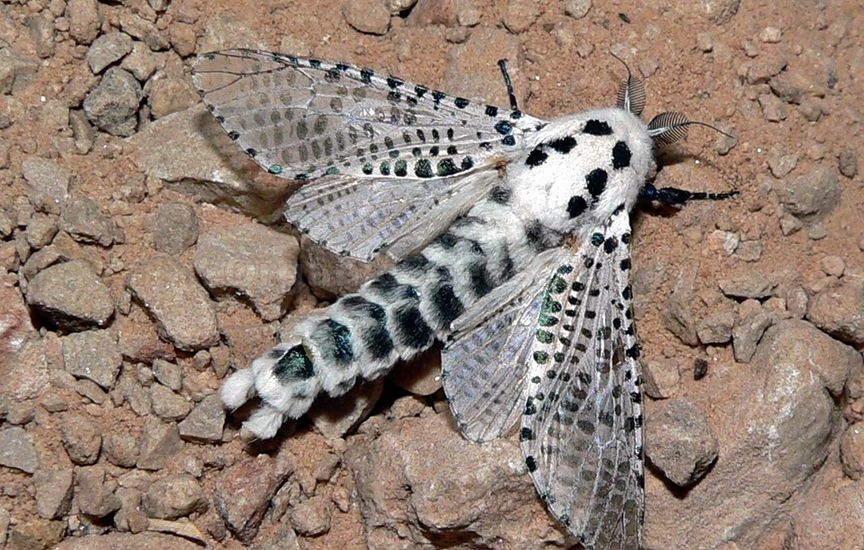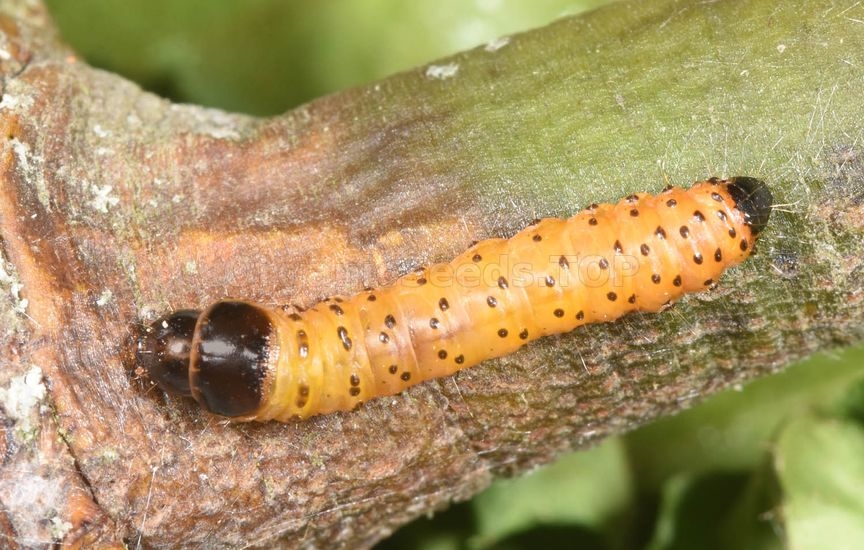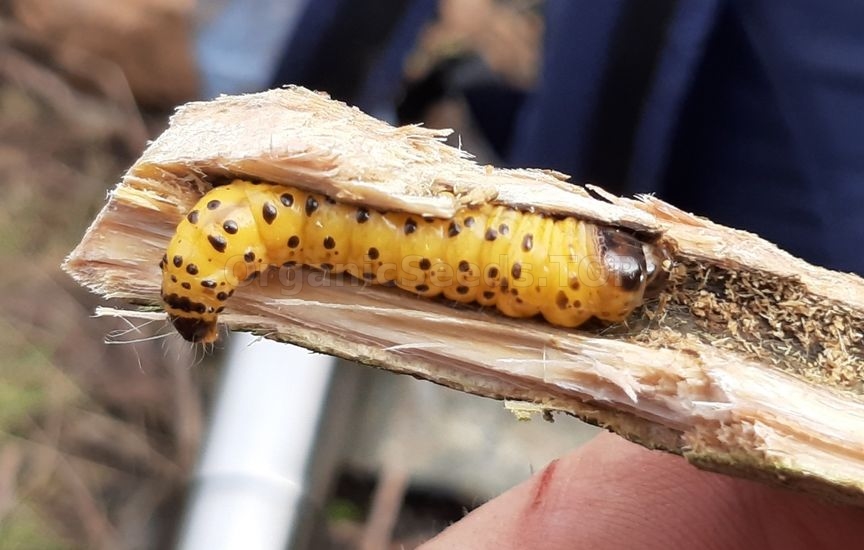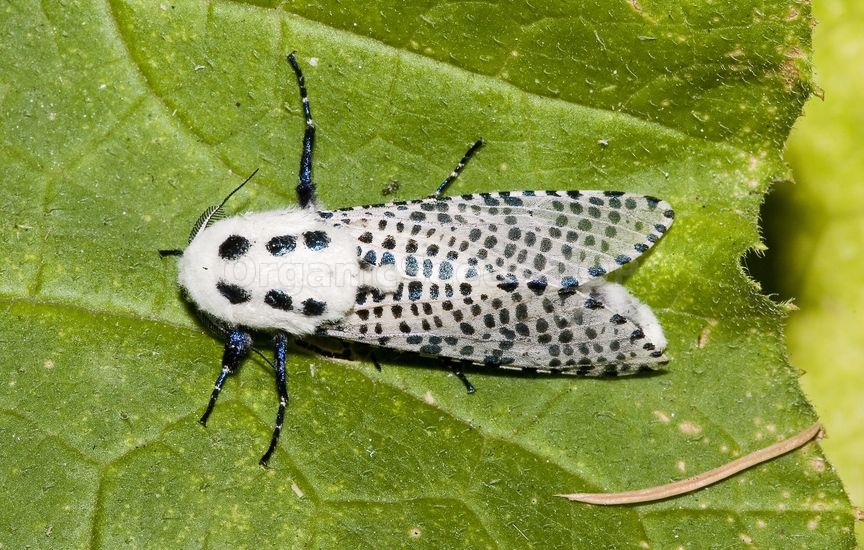Leopard moth - «Zeuzera pyrina» |
 Leopard moth - is a dangerous pest that causes significant damage to orchards, damages apple, pear, apricot, and walnut trees. Caterpillars damage more than 100 species of forest, fruit and ornamental plants. They gnaw holes in the wood and disrupt the flow of sap. Damaged branches become brittle and break even in light winds. Reproduction is bisexual. Full development can take two to three years. The first generation caterpillars overwinter under the bark, the second - in the wood of the host plant. MorphologyImago
Large moth. Wingspan up to 70 mm. The head is white with a black forehead, the chest is white with three pairs of rounded spots, gradually tapering towards the rear edge of the dorsal part. The forewings are whitish with numerous angular purple-black spots along the veins. The hind wings are translucent, except for the anal region, with dense small purple-black spots. The abdomen is black, the posterior edge of each segment is covered with white hair-like scales. A flat brush of the same scales is also observed at the apex of the segment. Like all representatives of the genus Zeuzera, the corrosive tree has narrow wings with a noticeably beveled outer edge and a white back with six dark spots arranged in pairs.  Sexual dimorphism Like all representatives of the genus Zeuzera, male pests have antennae - double-combed in the lower half, serrated above. The combs of females are much shorter, and the apices of the antennae are simple. In addition, the male genitalia are well developed; the branches of the copulatory organ are divided at the apex by a wide membranous bridge. Female genitalia: long telescopic ovipositor, anal nipples elongated, narrow, posterior apophysis more than twice as long as the anterior one. The wingspan of the male reaches 50 mm, the female - 70 mm. Egg The egg is oval in shape, up to 1.2 mm long, pale cream in color. Larva The larva (caterpillar), like all representatives of the woodworm genus, is large and naked. The head is large, slightly flat, the mandibles are wide. The abdominal legs are tenacious, their soles are equipped with numerous hooks. There are six hooks on each side of the head. The scutellum on the anterior thorax of the woodworm caterpillar has a raised posterior edge equipped with several rows of tubercles. On each body segment there are 10-12 dark brown plaques. Reaches lengths up to 60 mm. Color yellow, light yellow, pale pink. Each segment has black dots with short hairs. The head is black. The thickness of the caterpillar is up to 7 mm. Pupa Length up to 30 mm. Cylindrical in shape, dark brown in color. There is a horn-like process between the eyes. DevelopmentImago Butterflies appear in mid-June. Females are inactive, do not need additional nutrition and move only in search of places to lay eggs. Males fly within the crown.  Mating period Flight and egg-laying continue from mid-June to mid-August, with maximum intensity observed in the second half of July. The female lays up to 2000 eggs - 50-200 per clutch. The eggs are placed on the tree in various cavities, most often on dry wood of dead perennial branches. The eggs of the pest can be found near the buds, in crevices of the bark and forks of branches, often just in piles on the ground. Egg The embryo develops within 10-15 days. Larva The revival of caterpillars in the clutch occurs simultaneously. Young caterpillars crawl and hang on the cobwebs, and gusts of wind carry the pest throughout the garden. First, young caterpillars bite into the upper part of summer growths, directly at the base of the leaf petioles of the host plant. The tops of infected shoots wither and turn brown. The caterpillars feed in these shoots throughout August. Then they move to the lower parts of peer shoots or to perennial branches. The caterpillars finish feeding in the first half of October. They overwinter, feed a second time over the next year, and pupate in May of the third year. The life activity of overwintered caterpillars begins after the average daily temperature reaches above 10°C. During the entire period of development, the caterpillars often change feeding sites, and in the second year of life they bite into the wood of the trunk and, at a depth of 10-13 cm, gnaw out a single longitudinal passage directed upward. Pupa Pupation takes place in late spring or summer in the apical part of the plant, inside the wood. The nest is made from wood bits. The development of the pupa lasts two to three months. 
Leopard moth - damages various deciduous trees. Ash and elm trees in steppe shelterbelts and parks in dry southern regions, as well as many fruit trees, are especially affected. The insect causes harm at the larval stage. Caterpillars gnaw out passages under the bark and in the wood, thereby disrupting the movement of tree sap. Damaged trees become sick. Branches break off even in light winds. Red wormholes and caterpillar excrement are observed under the crown of infected trees.
You may need:«Leopard moth» trapPheromone trapsGlue trap (single adhesive cardboard) 205x125 mm |
|
|
